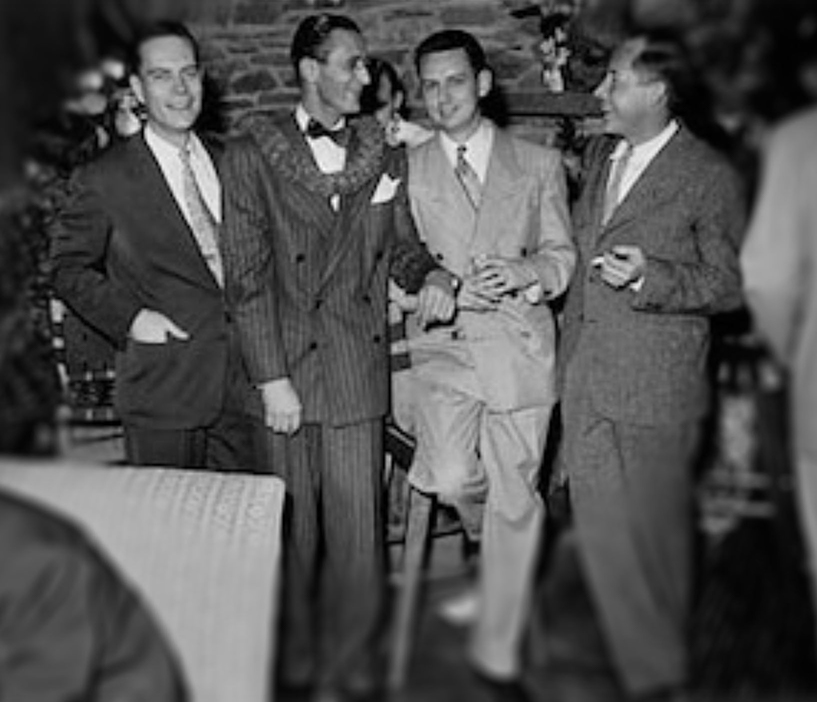Nicholas Peter Canlis was born in Sacramento, California, in 1913. to parents Nicholas and Susan. He grew up in Stockton, where his parents opened their restaurant The Food Palace and Fish Grotto in 1910. (Nims)
Peter Canlis left Stockton in 1939, determined to make his own way in the world and not follow his parents’ footsteps into the restaurant business. He traveled from California to Hawai‘i in 1939, where he initially sold shoes and then dry goods. (Nims)
“Following the attack on Pearl Harbor, the facilities at Pearl Harbor, Schofield, Hickam and elsewhere were being bolstered, while others were being created. Barbers Point Naval Air Station was developed.”
“The radio station at Lualualei was commissioned and rest and recreation facilities set up throughout Honolulu. The Armed Services YMCA was developed.”
“Peter Canlis, an employee of a suitcase and shoe supply company … was put in charge of the food facility there. We worked with him on the design of the kitchen and dining room.” (John Lind; Ian Lind)
“That food operation became a popular spot for civilian as well as military use. It was super and Peter Canlis became popular as a result. Following the war, Peter decided he was going to open his own restaurant.” (John Lind; Ian Lind)
“We were friends from Junior Chamber of Commerce activity and over several nights on my living room floor we made layouts of his proposed first Honolulu location in a small bungalow across the street from Kuhio Beach.” (John Lind; Ian Lind)
Canlis “was a guy who had a $1500 budget to convert a World War II blackout Chinese restaurant, called the Golden Palms, into an acceptable steakhouse.”
“And what do you do with $1500? You install a broiler so you don’t have to enlarge the kitchen. You push out and build a wall along the sidewalk so you can put in more tables which you protect with a striped awning. You get your wife to upholster banquettes with sailcloth so you don’t have to buy too many chairs.”
“And when I asked Peter what kind of a lighting budget he had, he said zero so we lit mostly with candlelight.” (WATG) Canlis opened The Broiler in 1947 about where the Hyatt Regency now stands.
Finally, the place opened. Peter didn’t have a liquor license so you brought your own booze. People complained about the high prices (a filet was $2.50) but flocked there anyway.” (WATG)
“In 1950, Peter Canlis moved to Seattle and opened the restaurant that would make his mark on the nation’s emerging fine dining scene. Borrowing all he could (fifty thousand dollars) he sought to build a restaurant in the heart of the city, but as an outsider he could not break in.”
“Unknown, untrusted, and with ‘an idea so crazy that Seattle would never go for it’ Peter fought to find his start. Famed restaurateur Walter Clark took an interest in the newcomer and offered a piece of land ‘way outside the city.’ Even as young kids we could recite his answer: ‘If it’s within a dollar’s cab ride of downtown, they’ll come.’” (Canlis)
“His impossibly lofty strategy was to build the most beautiful restaurant in the world. … He bet on upstart Northwest artists (George Tsutakawa’s first sculpture is still our door handle).”
“He snuck fresh fish from Hawaii on Pan Am flights and returned the same suitcases to The Broiler with salmon and Dungeness crab.”
“He built his lounge around a piano and the first post-prohibition liquor license in the city and priced his menu twice as high as the nearest competitor.” (Canlis)
“Then he invited kings and heads of state, business tycoons and civic leaders. He invited them before ever earning the right to. His experiment in Hawaii had worked and in Seattle he would double down on it.”
“Finally, waiting to serve a city of skeptics and naysayers, was his team of women of Japanese descent who had recently endured internment, clad in their own stunning kimonos.”
“Seattle fell for the restaurant and overnight, Europe’s 200-year, influential grip on American fine dining was under legitimate siege. In the years to follow, three more restaurants were built.” (Canlis)
The initial, rather casual, The Broiler closed in 1953; then, “In 1954, Canlis opened his iconic Canlis Broiler at 2100 Kalakaua. As late as 1985, it was described in a New York Times story as ‘a dependable old favorite with excellent food and service at moderate prices….’” (John Lind; Ian Lind)
Peter Canlis also opened Canlis restaurants in Portland at the Hilton Hotel, and in San Francisco at the Fairmont Hotel. Those restaurants operated, respectively, from 1963 to 1979 and 1965 to 1985. The Honolulu restaurant was open until 1989. (Nims) Honolulu architect George James (Pete) Wimberly designed all four Canlis restaurants. (WATG)
On July 6, 1977, Peter Canlis died at the age of 64 from lung cancer. After services held at St. Mark’s Cathedral, he was buried in his hometown of Stockton, California.
Among remembrances for the man who changed the face of fine dining in Seattle (and Honolulu) was this in The Seattle Times: “Pete was a much-honored restaurateur. He set a standard of excellence from which he never deviated.”
“He was a friend whose gruff exterior couldn’t hide a soft interior. He will be sorely missed by a lot of friends, who counted any day they saw him a brighter one”. (Nims)
































